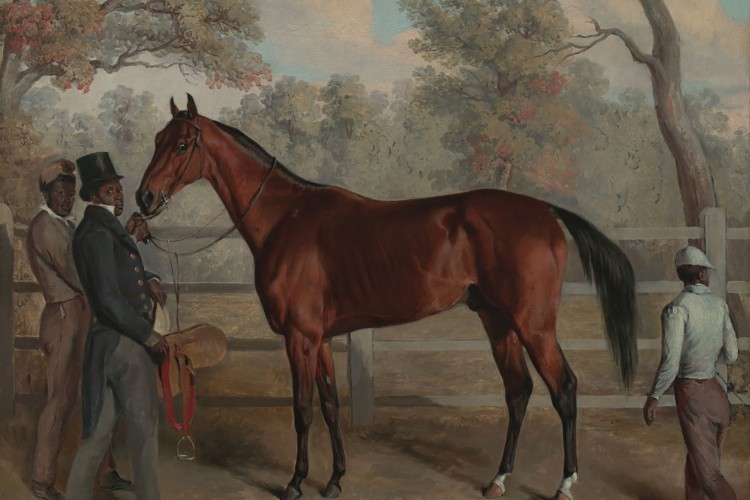Harry Lewis
Childhood and Family
Harry Lewis may have been enslaved and raised by Robert Burbridge, a hemp plantation owner in Scott County, Kentucky. Lewis married a woman named Winnie, and they had a son Lewis.1
Career as Trainer
Lewis worked as a trainer for Burbridge and later for Captain Willa Viley beginning in the late 1840s or early 1850s. Viley was an influential owner and breeder in the Lexington, Kentucky area.2
Working for Viley, Lewis trained the champion racehorse Richard Singleton. The famed equine painter Edward Troye painted a portrait of Richard Singleton and included Lewis in the picture.3
By the 1850’s Lewis was a free African American horse trainer in the household of Dr. Stephen Gano. Dr. Gano was the founder and treasurer of the Georgetown Jockey Club and a Thoroughbred breeder.4
Trainer of Lexington
Lewis is best known for training the horse Lexington (formerly known as Darley). Lexington achieved legendary status in his races, including a famous race against the horse Lecomte.5
In 1853, a dispute arose over the horse's ownership. Lewis could not outright own the horse. Lewis, who was free by 1850, negotiated an agreement with Dr. Elisha Warfield to lease the racing qualities of Darley.
The Thoroughbred was entered in the Kentucky Association Stakes (Phoenix Stakes) and the Citizen’s Stakes during the 1850 spring meet. Darley won both heat races. Between the two races, Warfield sold Darley to a consortium headed by Richard Ten Broeck. The group tried to claim the winning purses. The Kentucky Association settled the dispute and awarded the $2,500 to Harry Lewis.6
Legacy
Lewis’ impact on the sport extended far beyond training the iconic horse Lexington. The African American jockey Edward Dudley Brown owed much of his success to Lewis, as he rode Asteroid, Lexington’s offspring, to victory. Lewis also lives on in Edward Troye’s painting of the horse Richard Singleton. Though he was not the focus of the painting, he remains as a visible symbol of so many more African American horsemen of his generation.7
Additional Research Provided By
Yvonne Giles, Research Consultant
Sources
Davis, John H. 1906. The American Turf. New York, NY: J. Polhemus Printing Company.
Hervey, John. 1944. Racing in America: 1665-1865. SOLINET/ASERL Cooperative Microfilming Project (NEH PA-23166-98) ; SOL MN08572.01 KUK. New York: Privprint, the Jockey Club.
Hildreth, Samuel C., and James R. Crowell. 1926. The Spell of the Turf: The Story of American Racing. J.B. Lippincott Company.
“Listing for Richard Singleton by Edward Troye.” 2018. The Sporting Art Auction. November 6, 2018. https://www.thesportingartauction.com/product/32-edward-troye-swiss-american-1808-1874richard-singleton/.
Mackay-Smith, Alexander. 1981. The Race Horses of America, 1832-1872: Portraits and Other Paintings by Edward Troye. Saratoga Springs, N.Y.: National Museum of Racing.
Mooney, Katherine. 2014. Race Horse Men: How Slavery and Freedom Were Made at the Racetrack. Cambridge, Massachusetts: Harvard University Press.
Turf, Field and Farm. 1884, February 1, 1884.
“United States Census, Scotty County, Kentucky.” 1850.
Yvonne Giles. 2019. “African American Horsemen in Kentucky 1825-1950.” In Tales from the Turf. Louisville, KY: J.B. Speed Art Museum.
Citation
When citing this article as a source in Chicago Manual of Style use this format: Last name, first name of Author. Chronicle of African Americans in the Horse Industry. n.d. “Title of Profile or Story.” International Museum of the Horse. Accessed date. URL of page cited.






